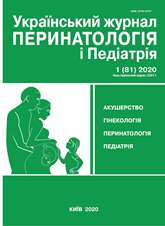HPV infection effect on the clinical course of chronic cervicitis
DOI:
https://doi.org/10.15574/PP.2020.81.54Keywords:
HPV-associated cervicitis, papillomavirus infection, dysplasia (CIN), complex diagnosisAbstract
The aim is to evaluate the effect of HPV infection on the development and formation of precancerous transformation of stratified cervical epithelium in patients for 3 years in the absence of drug, physiotherapeutic, or surgical treatment of the lesion.Patients and methods. The trial was conducted among 71 women of reproductive age 25–45 years old who were previously diagnosed with chronic cervicitis disease lasting for 3 to 7 years: the main group included 47 patients who at the time of the trial were diagnosed with HPV infection of highly carcinogenic types; the comparison group consisted of 24 women in whom negative indicators were found according to the results of PCR diagnostics of HPV infection of a high carcinogenic risk, but whose cytological results indicate signs of papillomavirus infection. All patients underwent comprehensive examination, which included general clinical methods: analysis of anamnestic and epidemiological data, general and gynecological examination. Special methods were used: advanced colposcopy, PCR method for establishing highly oncogenic types of HPV (16, 18, 31, 33, 35, 39, 45, 51, 52, 56, 58, 59), bacterioscopic testing of secretions from the cervical canal and posterior vaginal fornix, when necessary — biopsy. All patients were offered dynamic observation for 36 months.
Results. The most common types of HPV that cause the development of chronic cervicitis are types 16, 18, 31, 33, 58. HPV-associated chronic cervicitis is often accompanied by atypical colposcopic picture. Infections with a chronic course and conditionally pathogenic microflora lead to progression of abnormal colposcopic picture.
Conclusions. Women diagnosed with HPV infection of highly oncogenic types should consult a doctor for colposcopy once every 6 months, which will allow for timely detection of pathological changes in the cervical epthelium and prevent serious cervical pathological processes.
The trial was carried out in accordance with the principles of WMA Declaration of Helsinki. The trial protocol was approved by the Local Ethics Committee of the institutions indicated in the paper. The informed consent of women was obtained for the research.
The authors declare no conflict of interest.
References
Vaganova IG. (2000). Apoptoz i proliferatsiya epiteliotsitov ektotserviksa u bolnyih papillomavirusnyim i hlamidiynyim tservitsitom. Voprosyi onkologii. 46; 5: 578–582.
Zabolevaniya sheyki matki, vlagalischa i vulvyi (1999). Klinicheskie lektsii. Pod red. prof. V.N. Prilepskoy. Moskva: MEDpress: 427.
Kiselev VI, Ashrafyan LA, Budarina SO i dr. (2004). Etiologicheskaya rol virusa papillomyi cheloveka v razvitii raka sheyki matki, geneticheskie i patogeneticheskie mehanizmyi, vozmozhnosti terapii i profilaktiki. Ginekologiya. 6; 4: 174–180.
Ivanova ТА, Golovina DA, Zavalishina LE et al. (2007). Up-regulation of expression and lack of 5’CpG island hypermethylation of p16 INK4a in HPV-positive cervical carcinomas. BMC Cancer: 47. https://doi.org/10.1186/1471-2407-7-47; PMid:17359536 PMCid:PMC1831478
Meyer JL, Hanlon DW, Andersen ВТ et al. (2007). Evaluation of p16INK4a expression in ThinPrep cervical specimens with the CINtec p16INK4a assay: сorrеlаtiоn with biopsy follow-uр results. Cancer: 83–92. https://doi.org/10.1002/cncr.22580; PMid:17334990
Rocco JW, Sidransky D. (2001). p16 (MTS-l/СDКN2/INК4а) in cancer progression. Ехр Cell Res: 42–55. https://doi.org/10.1006/excr.2000.5149; PMid:11237522
Downloads
Issue
Section
License
The policy of the Journal “Ukrainian Journal of Perinatology and Pediatrics” is compatible with the vast majority of funders' of open access and self-archiving policies. The journal provides immediate open access route being convinced that everyone – not only scientists - can benefit from research results, and publishes articles exclusively under open access distribution, with a Creative Commons Attribution-Noncommercial 4.0 international license(СС BY-NC).
Authors transfer the copyright to the Journal “MODERN PEDIATRICS. UKRAINE” when the manuscript is accepted for publication. Authors declare that this manuscript has not been published nor is under simultaneous consideration for publication elsewhere. After publication, the articles become freely available on-line to the public.
Readers have the right to use, distribute, and reproduce articles in any medium, provided the articles and the journal are properly cited.
The use of published materials for commercial purposes is strongly prohibited.

